How to Make Microsoft Word 2010 One Continuous Document
Lesson 1: Getting Started with Word
Introduction
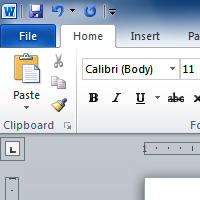
Word 2010 is a word processor that allows you to create various types of documents such as letters, papers, flyers, and faxes. In this lesson, you will be introduced to the Ribbon and the new Backstage view, and you'll learn how to create new documents and open existing ones.
Getting to know Word 2010
Word 2010 is a bit different from earlier versions, so even if you've used Word before you should take some time to familiarize yourself with the interface. The toolbars are similar to those in Word 2007, and they include the Ribbon and the Quick Access toolbar. Unlike Word 2007, commands such as Open and Print are housed in Backstage view, which replaces the Microsoft Office button.
The Ribbon
The new tabbed Ribbon system was introduced in Word 2007 to replace traditional menus. The Ribbon contains all of the commands you'll need in order to perform common tasks. It contains multiple tabs, each with several groups of commands, and you can add your own tabs that contain your favorite commands. Some groups have an arrow in the bottom-right corner that you can click to see even more commands.
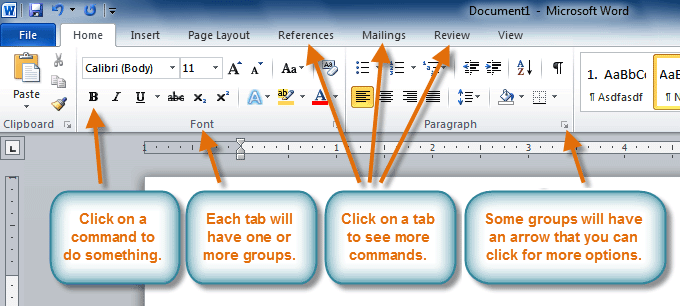 The Ribbon
The Ribbon
Certain programs, such as Adobe Acrobat Reader, may install additional tabs to the Ribbon. These tabs are called add-ins.
To minimize and maximize the Ribbon:
The Ribbon is designed to be easy to use and responsive to your current task; however, you can choose to minimize it if it's taking up too much screen space.
- Click the arrow in the upper-right corner of the Ribbon to minimize it.
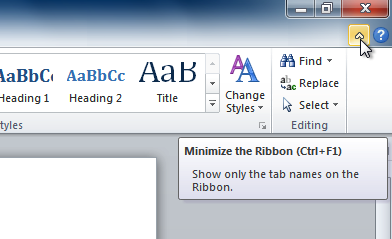 Minimizing the Ribbon
Minimizing the Ribbon - To maximize the Ribbon, click the arrow again.
When the Ribbon is minimized, you can make it reappear by clicking on a tab. However, the Ribbon will disappear again when you're not using it.
To customize the Ribbon:
You can customize the Ribbon by creating your own tabs with the commands you want. Commands are always housed within a group, and you can create as many groups as you want in order to keep your tab organized. If you want, you can even add commands to any of the default tabs, as long as you create a custom group in the tab.
- Right-click the Ribbon and select Customize the Ribbon. A dialog box will appear.
 Right-clicking the Ribbon to customize it
Right-clicking the Ribbon to customize it - Click New Tab. A new tab will be created with a new group inside it.
- Make sure the new group is selected.
- Select a command from the list on the left, then click Add. You can also drag commands directly into a group.
- When you are done adding commands, click OK.
 The dialog box where you can customize the Ribbon
The dialog box where you can customize the Ribbon If you don't see the command you want, click the Choose commands from: drop-down box, then select All Commands.
 Displaying All Commands=
Displaying All Commands=
Backstage view
Backstage view gives you various options for saving, opening, printing, and sharing your files. It's similar to the Microsoft Office button menu from Word 2007 and the File menu from earlier versions of Word. However, instead of just a menu it's a full-page view, which makes it easier to work with.
To get to Backstage view:
- Click the File tab.
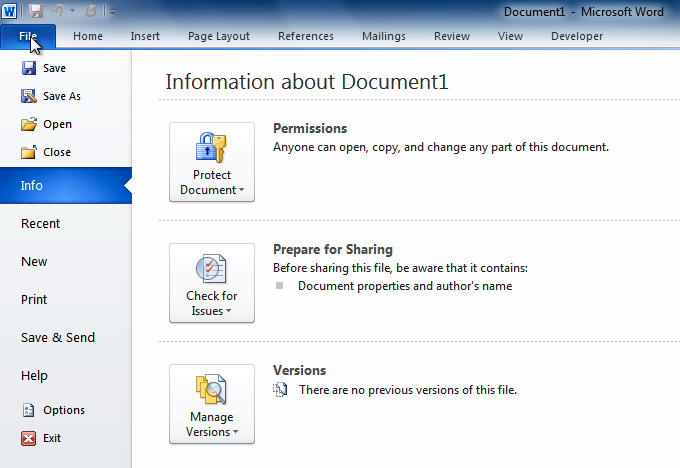 Backstage view
Backstage view - You can choose an option on the left side of the page.
- To get back to your document, click any tab on the Ribbon.
Click the buttons in the interactive below to learn about the different things you can do in Backstage view.

Recent
For convenience, recent documents will appear here.
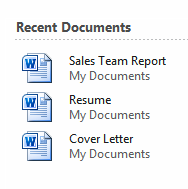
Info
Info contains information about the current document. You can also inspect the document and edit document permissions.
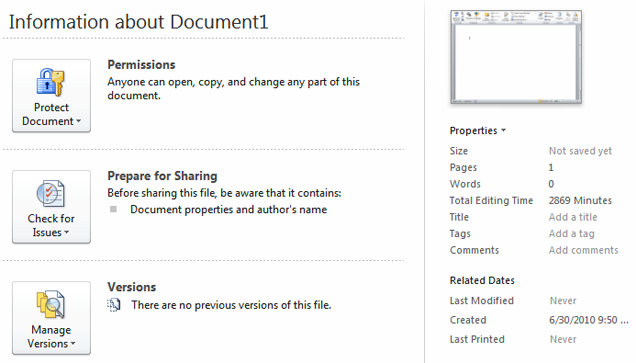
Save, Save As, Open and Close
Familiar tasks such as Save, Save As, Open, and Close are now found in Backstage view.
Options
Here, you can change various Word options. For example, you can control the spelling and grammar check settings, AutoRecover settings, and Language preferences.
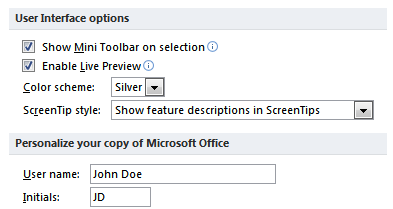
Help
From here, you can access Microsoft Office Help or check for updates.
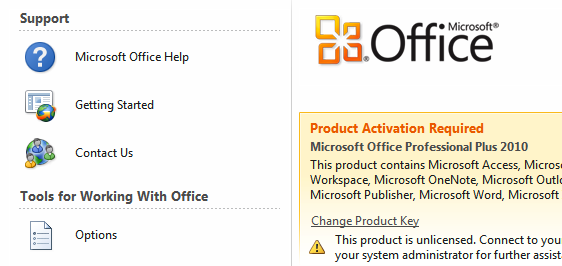
Save & Send
Save & Send makes it easy to email your document, post it on the Web, or change the file format.

From the Print pane, you can change the print settings and print your document. You can also see a preview of your document.

New
From here, you can create a new blank document, or you can choose from a large selection of templates.
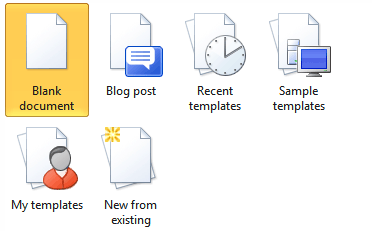
The Quick Access toolbar
The Quick Access toolbar, located above the Ribbon, lets you access common commands no matter which tab you're on. By default, it shows the Save, Undo, and Repeat commands. You can add other commands to make it more convenient for you.
To add commands to the Quick Access toolbar:
- Click the drop-down arrow to the right of the Quick Access toolbar.
- Select the command you want to add from the drop-down menu. It will appear in the Quick Access toolbar.
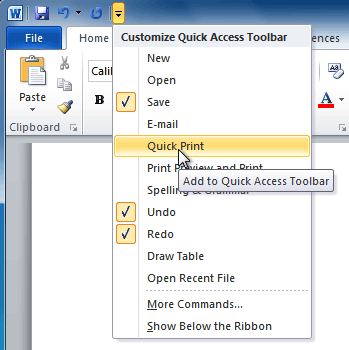 Adding a command to the Quick Access toolbar
Adding a command to the Quick Access toolbar
The Ruler
The Ruler is located at the top and to the left of your document. It makes it easier to adjust your document with precision. If you want, you can hide the Ruler to free up more screen space.
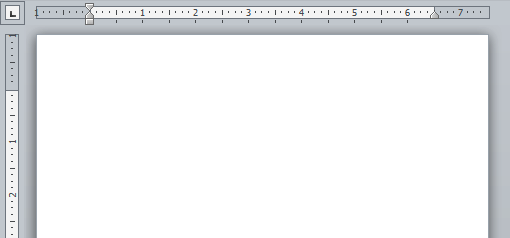 The Ruler
The Ruler
To hide or view the Ruler:
- Click the View Ruler icon over the scrollbar to hide the ruler.
- To show the ruler, click the View Ruler icon again.
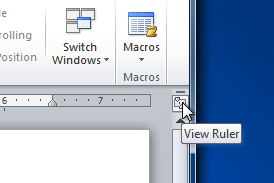 Hiding and viewing the Ruler
Hiding and viewing the Ruler
Creating and opening documents
Word files are called documents. When you start a new project in Word, you'll need to create a new document, which can either be blank or from a template. You'll also need to know how to open an existing document.
To create a new blank document:
- Click the File tab. This takes you to Backstage view.
- Select New.
- Select Blank document under Available Templates. It will be highlighted by default.
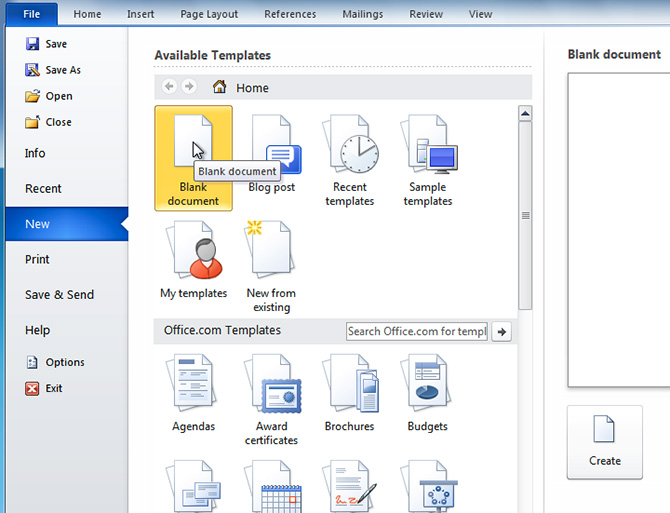 Creating a new document
Creating a new document - Click Create. A new blank document appears in the Word window.
To save time, you can create your document from a template, which you can select from the New Document pane. We'll talk about templates in a later lesson.
To open an existing document:
- Click the File tab. This takes you to Backstage view.
- Select Open. The Open dialog box appears.
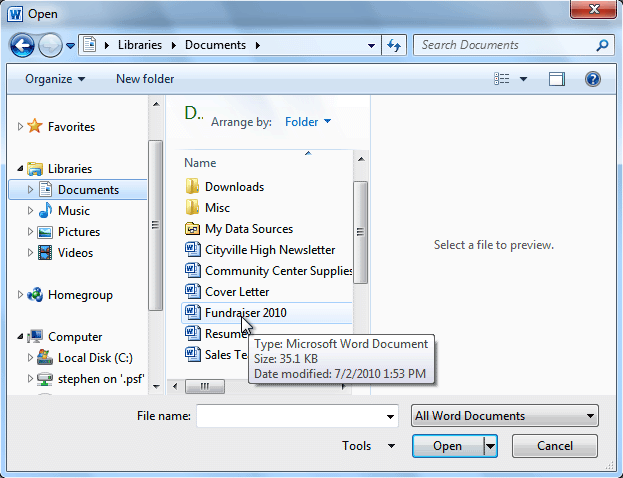 Opening a document
Opening a document - Select your document, then click Open.
If you've opened a file recently, you can also access it from the Recent Documents list. Just click on the File tab and select Recent.
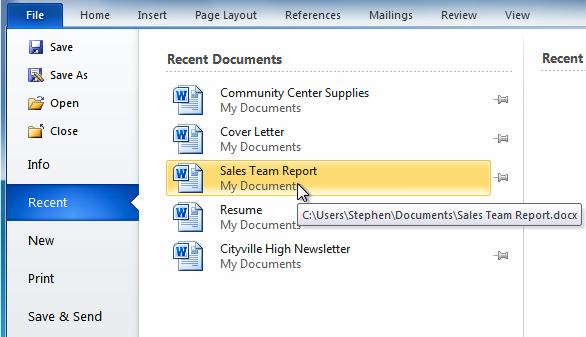 Opening a recent document
Opening a recent document
Compatibility mode
Sometimes you may need to work with documents that were created in earlier versions of Microsoft Word, such as Word 2007 or Word 2003. When you open these types of documents, they will appear in Compatibility mode.
Compatibility mode disables certain features, so you'll only be able to access commands found in the program that was used to create the document. For example, if you open a document created in Word 2007, you can only use tabs and commands found in Word 2007.
In the image below, you can see how Compatibility mode can affect which commands are available. Because the document on the left is in Compatibility mode, it only shows commands that were available in Word 2007.
 Compatibility mode vs. Normal mode
Compatibility mode vs. Normal mode
To exit Compatibility mode, you'll need to convert the document to the current version type. However, if you're collaborating with others who only have access to an earlier version of Word, it's best to leave the document in Compatibility mode so the format will not change.
You can review this support page from Microsoft to learn more about which features are disabled in Compatibility mode.
To convert a document:
If you want access to all Word 2010 features, you can convert the document to the 2010 file format.
Note that converting a file may cause some changes to the original layout of the document.
- Click the File tab to access Backstage view.
- Locate and select the Convert command.
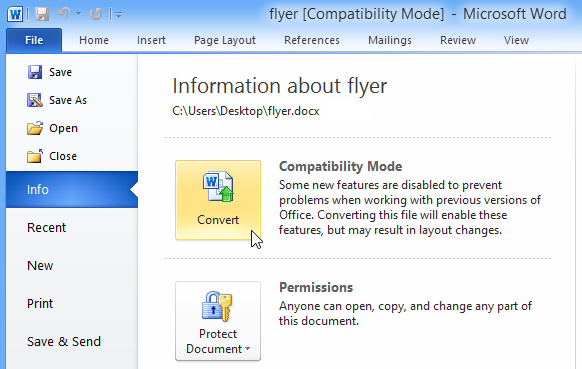 Converting the document to the newest file type
Converting the document to the newest file type - A dialog box will appear. Click OK to confirm the file upgrade.
 Clicking OK
Clicking OK - The document will be converted to the newest file type.
Challenge!
- Open Word 2010 on your computer. A new blank document will appear on the screen.
- Make sure the Ribbon is maximized.
- Display the Ruler.
- Add any commands you want to the Quick Access toolbar.
- Close Word without saving the document.
/en/word2010/text-basics/content/
odellthembine1969.blogspot.com
Source: https://edu.gcfglobal.org/en/word2010/getting-started-with-word/1/
0 Response to "How to Make Microsoft Word 2010 One Continuous Document"
Postar um comentário